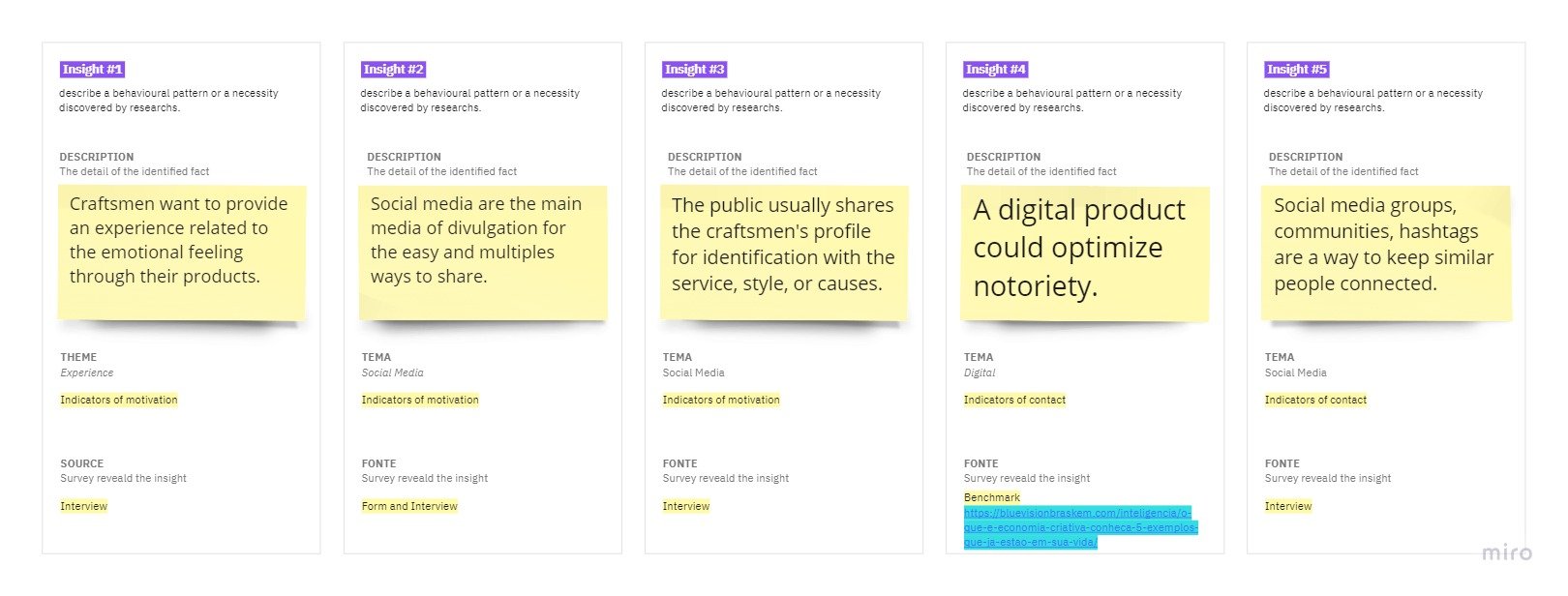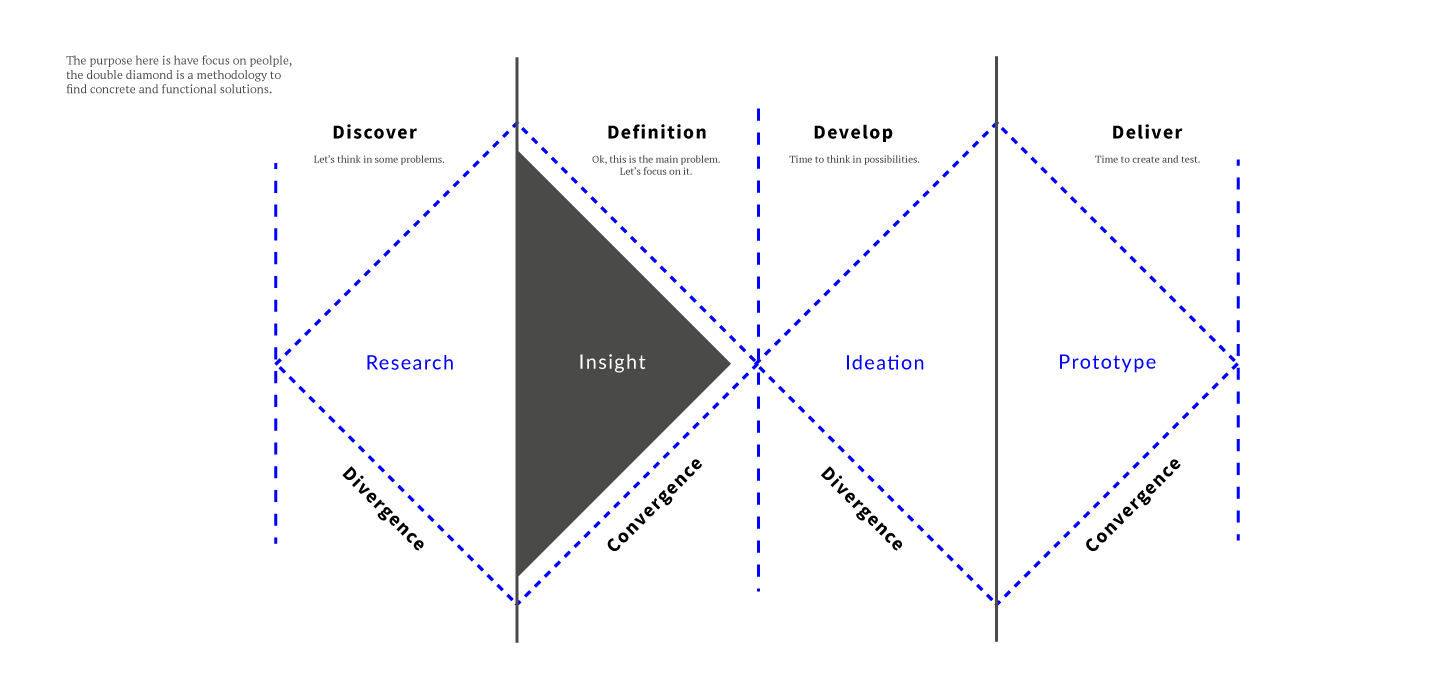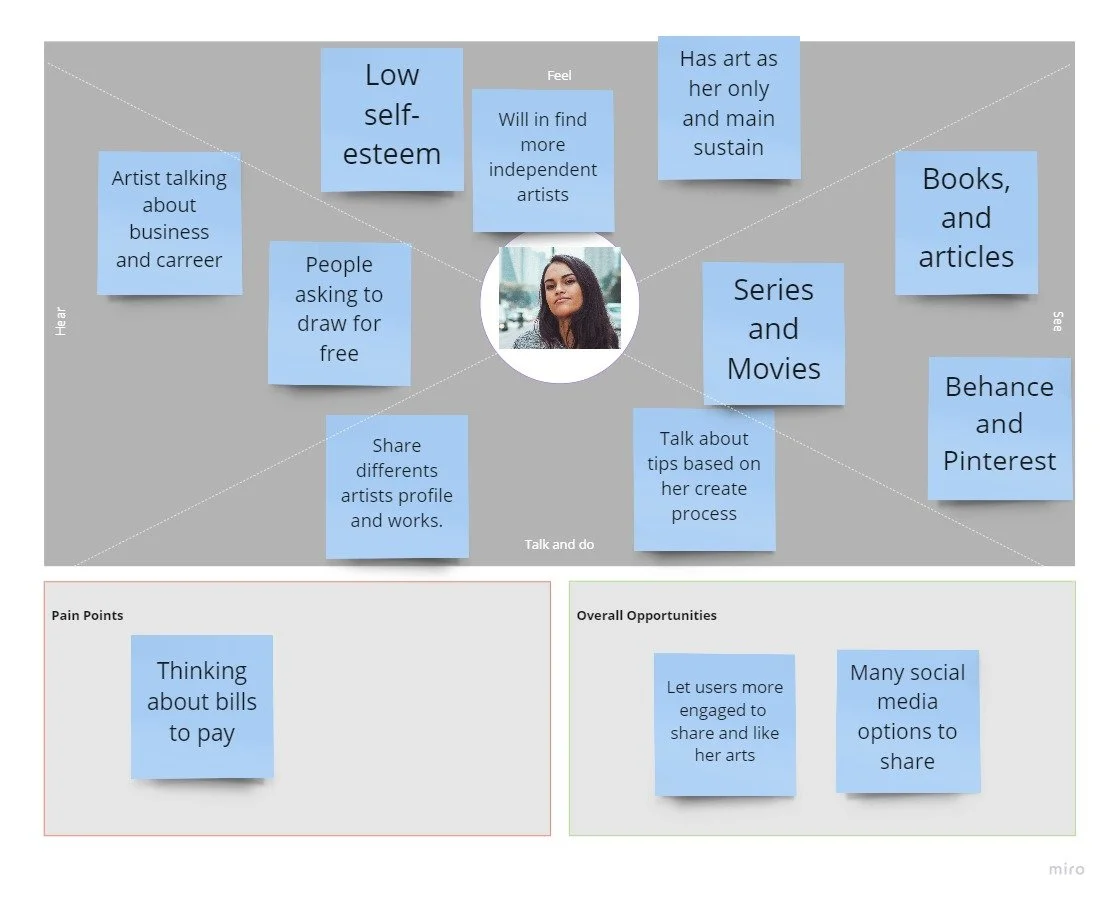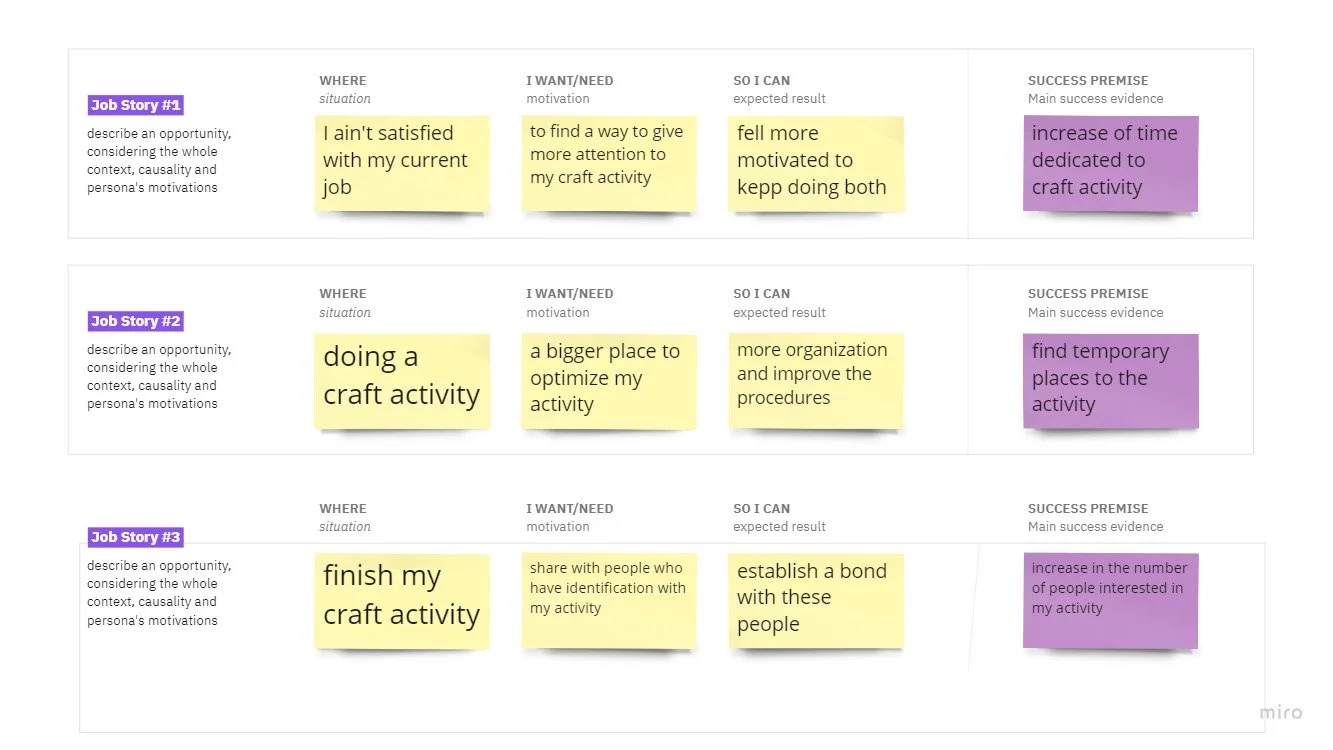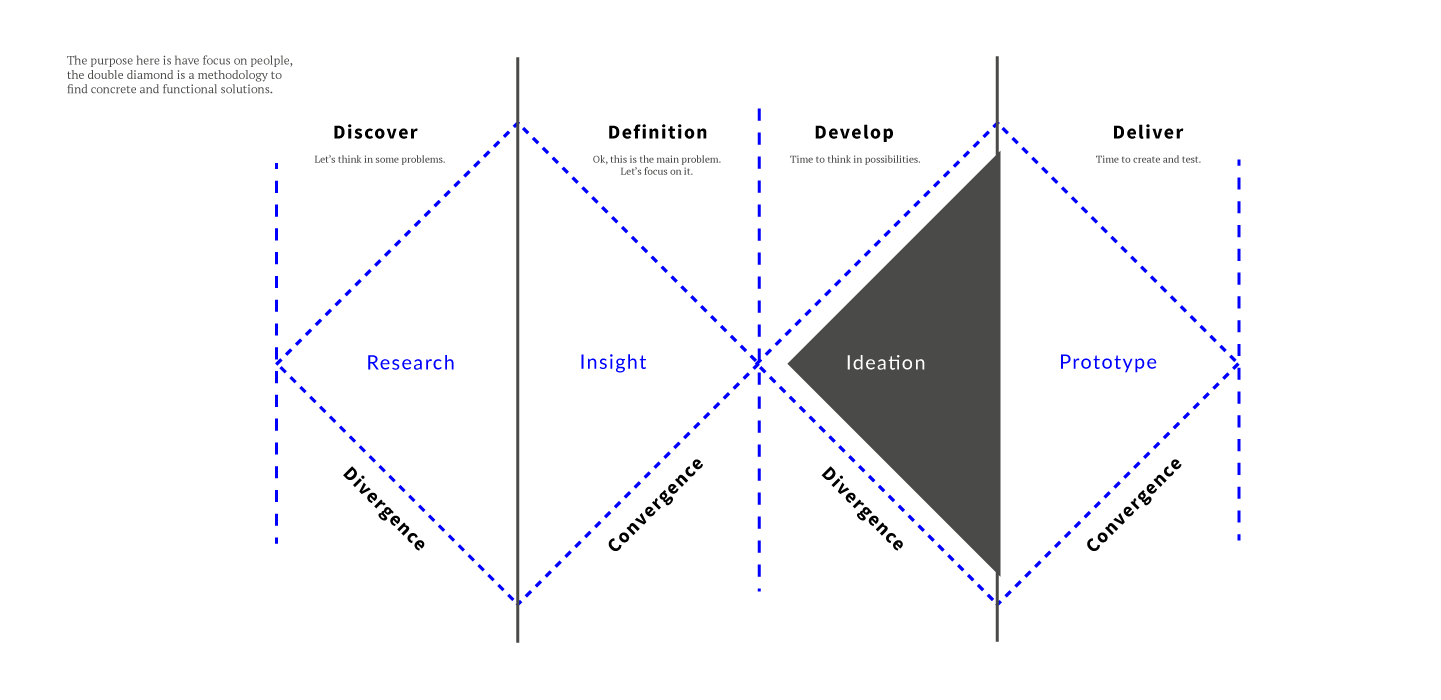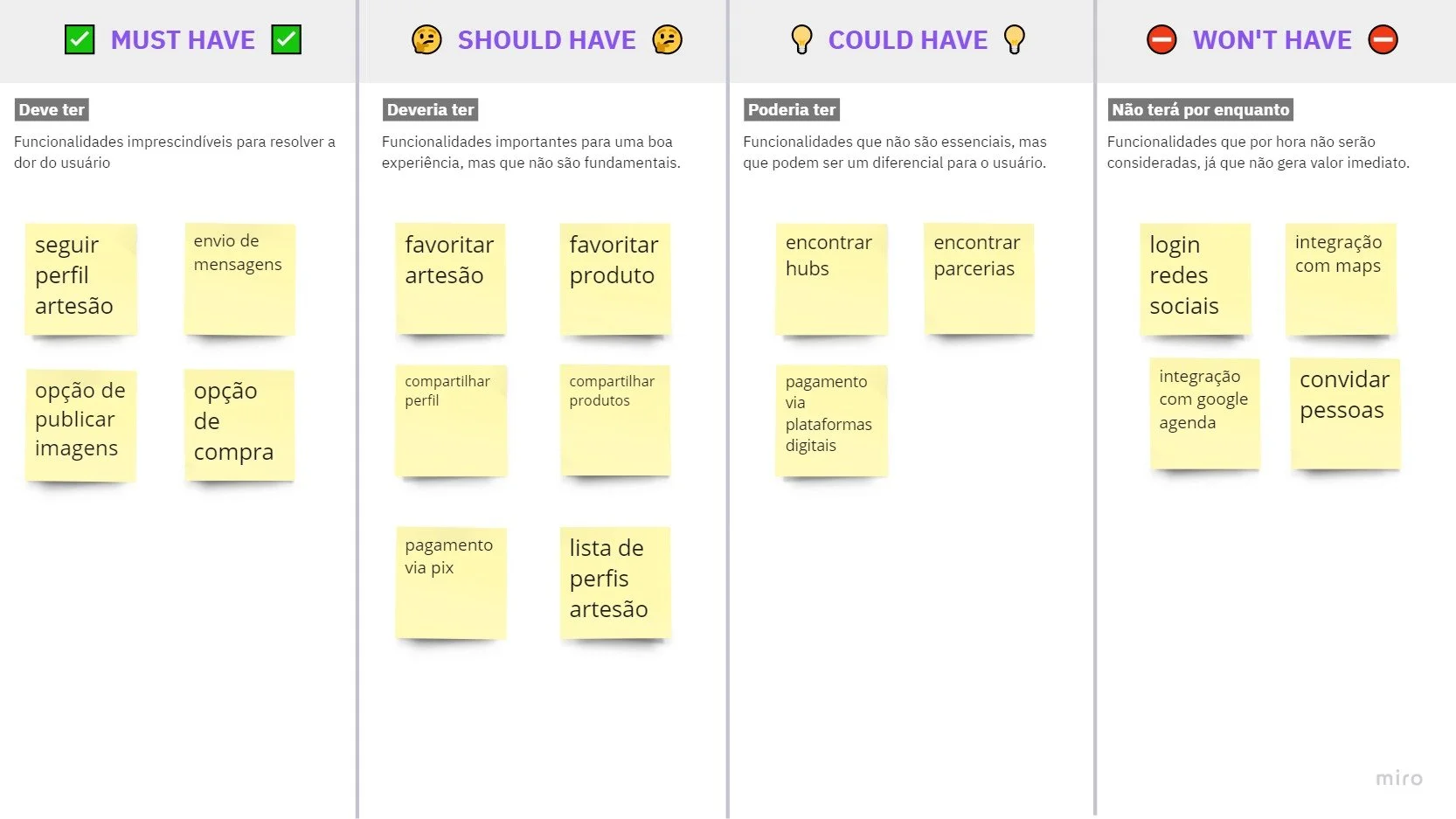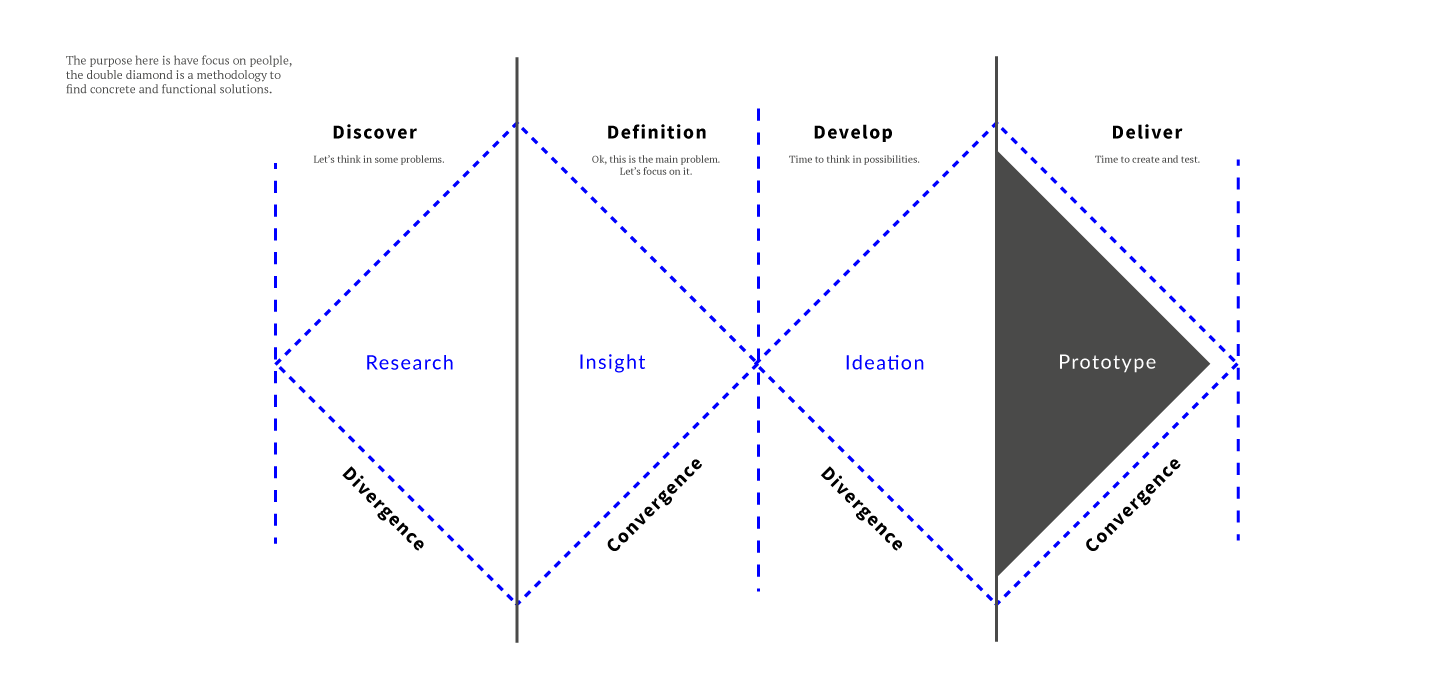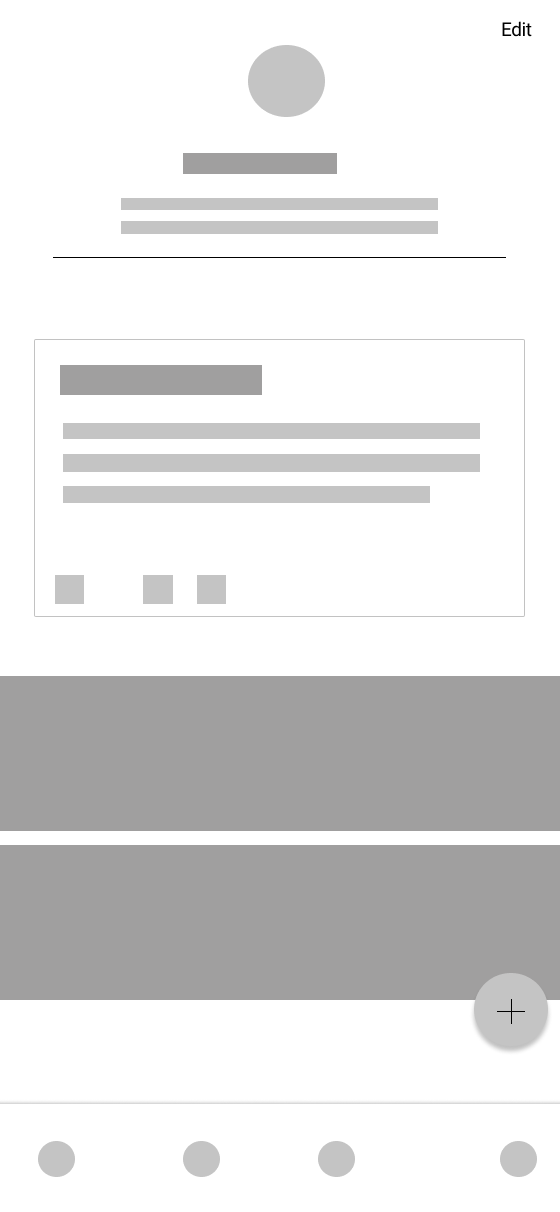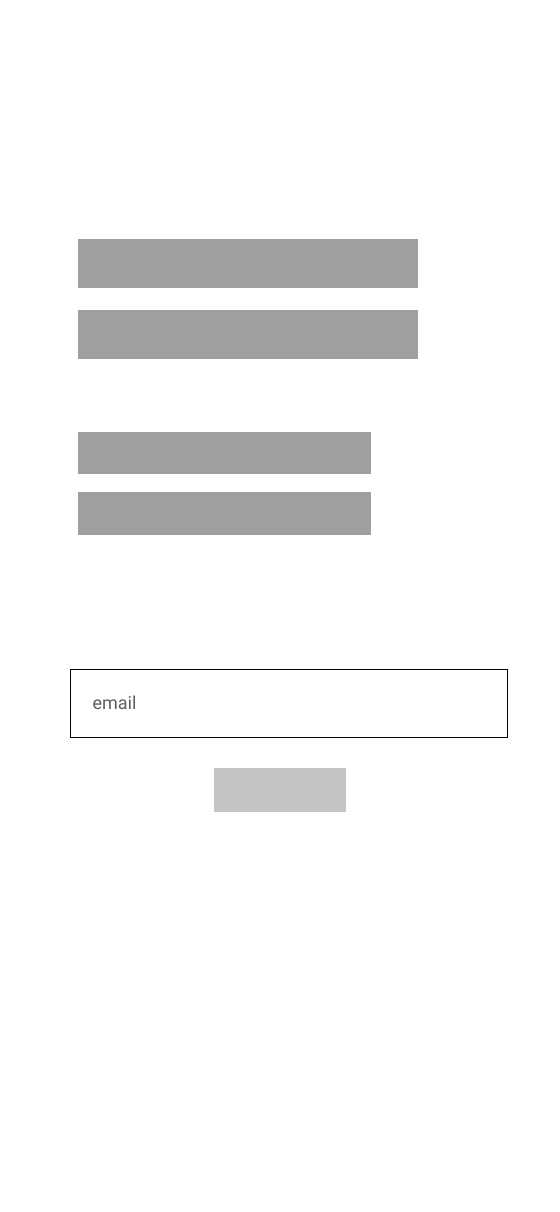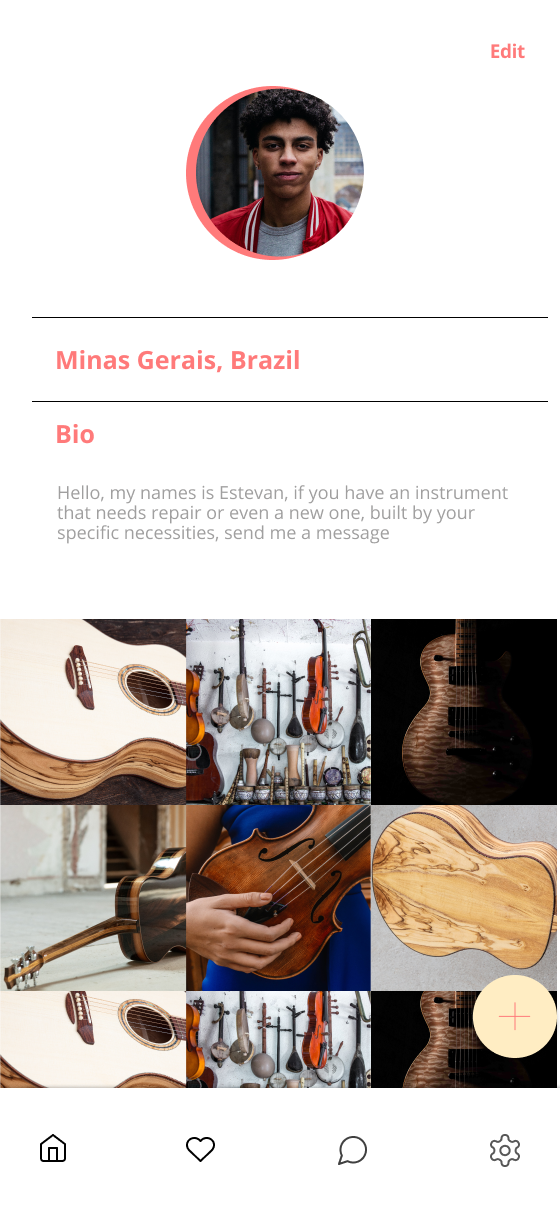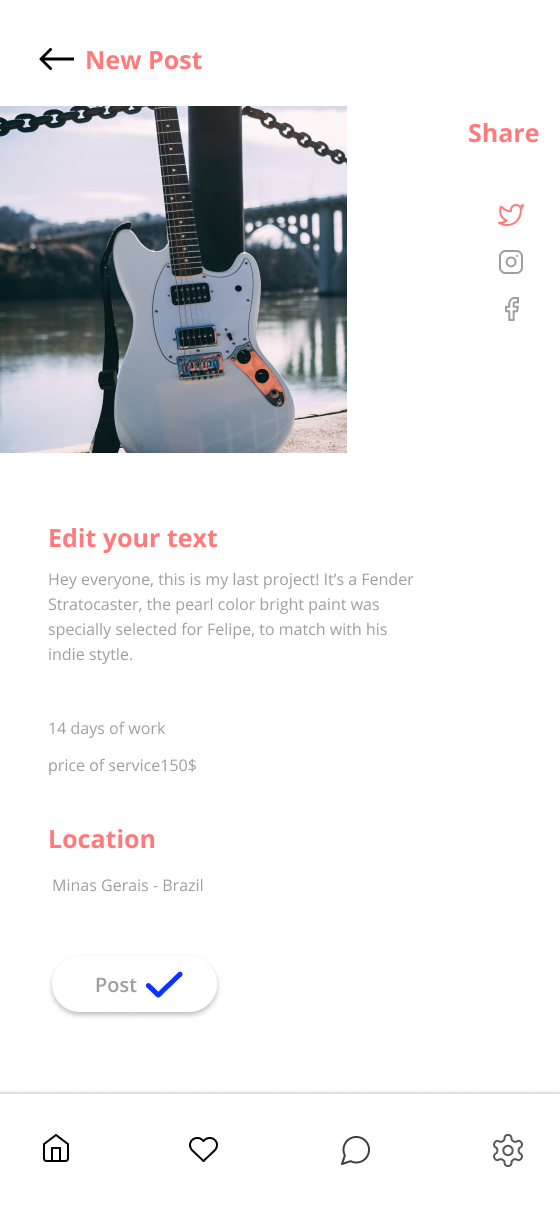craft to the future
A UX study case of regional creative economic and digital opportunities.
A project was born
The following project was made by me, it's a solo case of study, constructed during the course of UX Design by How Bootcamps in 2021. This case has been made with an immersion over 10 weeks of learning, doing, and learning again. Using the methodology of Design Thinking with Double Diamond, based on a real-time problem: the Pandemic. It's also focused on those who still need a little hand, people like you and me.
First things first, the big question
To introduce this case, it's important to explain what problem should be solved, moreover, what kind of scenario we are ready to be into. 1.392.758 was the number of brand new companies in the four-month period in Brazil in 2021. This is an indicator that professionals are more encouraged by the will or needs, to have more control and independence of their own economics.
But there is more
The creative economy was one sector that has been affected since the beginning of the Pandemic in 2020, on the other hand, it was a sector that suffered from the emptiness of one of the main points of contact with the customer, the streets. The craft market is responsible for an injection of R$ 50 billion per year in Brazil.
We still have a mix of desires and necessities with these people who has a traditional job but want to do more and with more passion, they also want the emancipation of a regular job, and the big question of this study case is: How might we boost these professionals?
Make them digitally visible.
The crafters
The target is professionals who made a type of work with their own hands, in a non-sequential way, which means: If you create something that depends on your creativity, it's not an industrial procedure scope, you're a crafter. There is more... if you made this with digital interaction, you're a crafter 2.0
The First Diamond
We begin with the first quarter of the Double Diamond, searching for relevant information about the market, human comprehension, and a lot of research, to avoiding thinking on the solution before the context.
First step, the divergence.
Matriz CSD
The first step is to put all the information that we certainly know, what we suggest, and what we have doubts.
The first method was the Matriz CSD, it's a kind of monologue that we start to put the things that we know, what we suppose and what we don't have conviction.
What do we know about? (100% of certain)
People have more proximity with products and brands in digital;
Internet optimizing the divulgation of products and services;
Craft and economic creativity are more popular nowadays;
Increase in number of entrepreneurs and autonomous artists;
What are our hypotheses (or what we assume to know?)
Decrease on number of buyers in craftsman's services and products ;
Artists are more connected in social causes;
People have more proximity with products and brands in digital;
Better identification between customers and products;
It's qualified as a non-essential service;
The main point of divulgation it's on social media;
Brings benefits to the local labor.
What we can't affirm? (and certainly should be asked)
It's the main source of income?
Whats is the method to interact with the customers?
Whats is the main point of contact with the public?
It's has been increased the number of customers during the Pandemic?
Does the activity depend on some government support or incentive?
How much does this represent?
The activity could be taught?
There is a desire in expanding?
Desk Research
Collecting data, it's a good way to structure the Matriz CSD with information that is and should be validated after.
Brazilians are using more cellphone to buy something or make transitions;
28,4% more connected on smartphones than 2020;
Online shopping has increased by 31% in 2021;
15% of young users (16 -29 years old) use Instagram to buy things;
and 16% use Instagram to disclose products, services, or brands.
Having the idea that people are more connected, opens possibilities for craftsmen to spread their service, but first, we need to discover what they really need, what they like, where are the pain and the glory in their history, we start to ask.
Surveys - Quantitative Research
After having the previous information collected, it was set up an online survey to bring more information about the target of this project. The survey was focused on people who work within a crafts activity or do it as a hobby with the possibility to expand and gain money.
The survey chosen was Google Forms;
18 people filled the survey;
The results showed how they appear to the public on digital platforms;
They use social media, but in a basic or limited way;
Instagram is the most used;
They intend to invest more time, but just a few really do;
38,8% of surveyed felt the impact of the Pandemic, which means fewer customers buying or make direct contact, while 27,7% have this activity as the main resource income.
With the first data collected, we understood that people don't want to risk and put all their efforts into this activity now, it's safer still maintain the traditional job, like or not.
Surveys - Qualitative Research
The interview was made with three people with different profiles.
A person who wants to invest more time a make the activity turn into his job.
A person who doesn't have a goal to live by his activity, but could think in the future.
A person who works with his activity and 100% of the resource income is provided by it.
During the interviews, it was possible to understand the inner reasons why they do the activities, and what is the prize at the end of the rope. The feeling of delivering something unique and made thinking on the person necessity or desire. There is a special bond between the craftsman and the customer, even though sometimes it can be quick, the synchrony it's something that fills that type of work.
We have the responses, so now while we confirm and update the Matriz CSD, we also start to think about insights.
Card Sorting
This method helped to organize the ideas in a visual form according to the qualitative responses and what would be interesting to the project and what can be discarded.
Categorie 1 - Indicators of motivation (Why the activity would successfully work)
Contact with the activity happened early (childhood or as a teenager);
Do what they really like;
The purpose in making their service an unique experience to customers;
The activity is also an opportunity to expand naturally new abilities;
Stronger bond with their audience/target/customer.
Categorie 2 - Motivators of contact with customers. (Why the audience would make contact)
User appointments to new customers by social media;
Appointments by common friends;
Customers could already have in mind what kind of service/product they need;
Specifics groups tend to share spontaneously the craftsman's work.
Categorie 3 - Inhibiting of success. (What could demotivate)
The activity doesn't sustain by itself;
The lack of time to dedicate for activity;
The necessity of a big investment in the activity;
The lack of an appropriate space;
The lack of appropriate tools;
The urge in has more confidence in the activity.
Time to have insights
Here was find behavioural patterns that allowed us to think strategically about them.
The end of the first half of the double diamond, allowed me to understand that there is a will, on the other hand, exists a doubt to put more money to invest, or even more energy to make the activity more rentable and professional.
First Diamond, second part
We begin with the first quarter of the Double Diamond, searching for relevant information about the market, human comprehension, and a lot of research, to avoiding thinking on the solution before the context.
Stop, Convergence time!
about me
I'm Bacharel in Advertising;
I have worked as a graphic designer;
I currently am an autonomous digital artist;
My Routine
I live with my girlfriend;
I have a calm and organized routine;
I use social media only to keep active my artist profile;
I go out just for essential tasks;
After the pandemic, I intend to still work at home;
My work's totally remote.
Motivations & Hobbies
I like to watch series and movies;
Hangout with my girlfriend to eat burgers;
Spend time with my cats;
Make trips to recharge my energies;
I avoid waste time on Whatsapp.
Pain Points
Be more confident (impostor syndrome);
Art is a small value sector;
Speak in different languages;
Softwares and gadgets are expensive.
Overall Goals
Keep studying;
Make art level always with high quality;
Doesn't need a traditional job anymore;
Motivate amateurs and beginners artists;
Think less in financial situations (bills and payments).
Personas
One persona were constructed according to the interviewed personalities and base information.
Personas will be guiding the following decisions and make the digital product more assertive.
What kind of methods did you use while developing the personas? (User research, or involving stakeholders?)
Context, problems, motivations, and overall goals are included in the study
How did you present this information to the product team?
Personas will affect the design, because the needs, make the user's journey more reliable.
Empathy Map
We can truly use the word map here as his full meaning, the previous information collected is now used to understand clearly the context of the current situation of Brenda and Estevan. It is possible to see that even though they are in different situations, the needs of both guided to thinking in a digital product that fits in their reality and that doesn't make the time on the cellphone be extremely useful.
Job Stories
The simulation of the Job Stories process put the personas to reach a successful goal, however, the steps that show the situation, motivation, and the expected results lead to carry it to the digital product.
Brenda wants to make their audience bigger and more prepared to understand that her job has value and reasons to be worth the money.
Second Diamond
We begin with the first quarter of the Double Diamond, searching for relevant information about the market, human comprehension, and a lot of research, to avoiding thinking on the solution before the context.
If the first diamond was the phase responsible to understand and make connections with the public and the points that are painfully and motivational according to their own goals, here it's time to summarize the data and make things happen, I mean, make things create forms and colors. Ideation is an open process that allows thinking in solutions looking closer through the problems collected, and guided by the following question.
How might we increase the motivation and visibility of craftsmen and products?
The very first step is to put the ideas on the table and after this select the promises ones.
moodboard
In parallel, visual references are collecting to make the digital product more tangible.
If the first diamond was the phase responsible to understand and make connections with the public and the points that are painfully and motivational according to their own goals, here it's time to summarize the data and make things happen, I mean, make things create forms and colors. Ideation is an open process that allows thinking in solutions looking closer through the problems collected, and guided by the following question.
How might we increase the motivation and visibility of craftsmen and products?
Heuristic Analysis
Take a look into the brand's systems that have common points in interactions and usability, make it possible to understand not only software and its functions but also what could be efficient for the user with a specific necessity.
Two systems were analyzed, Twitter and Airbnb, each one has a truly specific characteristic to made their public achieve a goal with flexibility with few touches.
Findable
Measure how simple it is to find information.
Pros
Easy to identify or find some topic with hashtags;
Good search tool;
Trend Topics;
Share with Retweets
Cons
Find a specific tweet can be difficult.
Controllable
Measure the level of control and customization allowed.
Pros
Customization of profiles is simple and quick;
Easy to find groups.
Cons
Profiles can be emulated easily;
Profiles can be mistaken.
Delightful
Measure the difference in relation to similar competitors' services.
Pros
It has extremely loyal users;
It didn't need big changes during the years;
There is an equilibrium between humor and informative content;
Cons
Increase of political content.
Accessible
Measure how simple it is to access and navigate through.
Pros
Easy to identify the most important tweets to the regular ones.
Cons
Huge quantity of information on the screen;
Easy to lost focus.
Valuable
Measure the level of desire and importance for the users.
Pros
Real-time information;
Fast updates.
Cons
It can be suffocating the quantity of information.
Clear
Measure how simple it is to conclude a task.
Pros
The user can choose how he will navigate; (topic, for people, or hashtag).
Learnable
Measure the rate of easiness to learn and use the solution.
Pros
Intuitive Interface.
Cons
There is not a tutorial like some other social media.
MoSCoW
At first, the app Craft would be created with the fundamentals procedures and features, using the MoSCow matriz, it will be visually easier to understand what is the priority, and what could part of the app on the next upgrades.
User Flow
An important step is to draw the path that the user will pass to conclude an objective, in this case, would be to make a new post in the crafter's profile.
The Craft going to visual
At this point, we summarize all the information collected with the users and researchers, moreover, the insight and ideation procedures made us think about the digital product, with the big question defined and ready to be answered, the project is now leading to solving a problem.
How might we encourage the crafters to spend more time on their services and products?
- Delivery a possibility to have a digital gallery with contact points.
The Craft app will be a local that it was possible to know artists the art exhibited on profile, with the chance to link all the social networks contacts to improve the confidence and make transitions without leaving the platform, for example.
Clarice is a person who wants to improve her activity while she keeps her formal job. The Craft could make this more tangible, creating a new profile on the app, she can define the type of art that she will be found by, linking with the other social media to enhance and avoid the possibility of fake accounts, and the transitions could be dealing in the app, with this both the buyer and the selling have the transitions regarded by the app.
The last face of the diamond
To make our way here, the path through the 3 previous parts was done. The last division of double diamond is about testing. Here all the information, pain points, opportunities, analysis, and ideas start to emerge into something visual and usable.
It's time to make prototypes.
If the first diamond was the phase responsible to understand and make connections with the public and the points that are painfully and motivational according to their own goals, here it's time to summarize the data and make things happen, I mean, make things create forms and colors. Ideation is an open process that allows thinking in solutions looking closer through the problems collected, and guided by the following question.
Sketches & Wireframes
To create a good interface, pen and paper are very important, to summarize, organize and even discard possibilities.
The main purpose is to put out of the brain the ideas that were thought in all steps. The focus is not to seem pretty or proportional, but functional as a first interface idea.
the first look
Onboarding Screen
The visual was created in two main colors - red and yellow ochre. The color Red in a lightning tone is to pass the sensation of comfort, and the yellow ochre represents the handmade material.
The Craft will be designed by both IOS and Android platforms. The screen traditions will be a point of focus, to provide a good first experience for the user.
Final Considerations
The Craft has the goal to make people who want to migrate from their formal job or even the ones who already have a small business spend more time and be more visible to the customers.
To conclude this case of study, The Craft is a digital wallet that will exhibit the work in an organized way, giving the priority to show, make bonds and motivate more and more this kind of entrepreneurs who already has the talent in their own hands, the Crafters.




